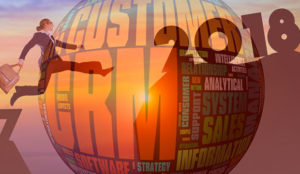As the B2B buyer continues to evolve, B2B sellers have more solutions than ever in their technology stacks. From CRM, sales content and asset management, to sales enablement, LMS and more, these technologies have been adopted in order to stay ahead of the changing behavior of prospects.
However, while the adopter of these solutions has good intentions and hopes to drive individual sales while increasing the team’s productivity, that is not always the outcome. Specifically, many sellers often are overwhelmed and lack trust in such tools, due to little training and an obscured view into each tool’s benefits.
Even a tool as vital as CRM is not adopted by all sellers. Although almost all the participants in a recent CSO Insights study said they had a CRM system in place, 32 percent of them admitted that their systems were less than three-quarters adopted. What does this mean? Even though sellers have been adopting tools to maximize results and productivity, because of vague insight into each tool’s benefits, overall adoption has decreased.
This is vital for sales leaders to understand, specifically as it relates to CRM. As the predominant piece of sales tech, CRM plays an integral role in sales success, so why are organizations looking past sellers who choose to not use it?
In the age of instant gratification, it appears that sellers see manual data entry as the No. 1 challenge to full CRM adoption, according to HubSpot. Though CRM applications provide valuable at-a-glance data and reports about sales performance, they do not provide much assistance to the seller, especially in the moment, as the seller is recording prospects and opportunity details.
Think about the amount of information a seller must log after each sales interaction. When sellers don’t have to manually insert that information, it not only impacts the relationships between the seller and buyer, but also impacts the sales team at large, fostering learning and growing from others. Ironically, I think optimal adoption of CRM requires assistance from another tool, a sales enablement solution. When it is integrated with CRM, sellers are more efficient, productive and successful.
Optimize Internal Workflows
It’s an ongoing battle for marketing teams to enforce the sales team to use marketing collateral. When sales enablement solutions and CRM are integrated, however, it creates one source of content and data for sellers. One source of information makes it easier for sellers to have prospect details at their fingertips. Further, they can prepare, present, and follow up on meetings via a single platform.
With data from a sales enablement solution and CRM combined into one platform, sales and marketing leaders can more accurately evaluate the content that is used most frequently, the content that most often drives sales, and more. These evaluations can drive both departments’ strategies, in order to create the best content for prospects based on industry, buyer persona, and opportunity stage to continuously replicate and scale successful sales cycles.
Decrease Sales Admin Time
While the data gathered from CRM and sales enablement platforms is used to make sales strategies smarter, it is often input manually, taking away time that sellers could be using to sell. Nearly two-thirds of sellers’ time is spent on activities not related to selling, based on a recent Clickfunnels study. Integration of sales enablement and CRM tools can reverse this and restore time to sellers’ days. Among the things they can do to relieve sellers from administrative tasks:
- Automatically track sales interactions and meetings in CRM as they happen;
- Automatically track content used in sales meetings, recording notes related to the opportunity, saving the seller from inputting the information later and offering the marketing team insight into how sales content is performing;
- Serve as a centralized source for customized presentations for sellers to lead value-driven discussions; and
- Provide access to the most up-to-date, on-brand content both on and offline.
Evaluate Impact on Sales Effectiveness
An important part of improving sales strategy is evaluating what is working and what is not. Sales leaders are looking at the bottom line, but marketers also are looking for feedback on content. What content is working and actually is being used in customer meetings? Why are deals stalling? Is there a piece of content that moves deals forward?
With the combination of sales enablement and CRM, the materials that are used in each stage of the sales process are recorded automatically. That way, sellers and marketers have a better idea of what content drives deals forward, and they are able to assign ROI to specific pieces of content.
This information provides a one-two punch of benefits for sales and marketing teams. The marketing team not only can track the use of content by the sales team, but also can dive deeper into specific pieces, evaluating what type of messaging resonates.
This also helps CMOs by showcasing real-time data and insights to support strategic decisions and roadmaps for future content creation. This information also can be sliced and diced by deal information, such as size, industry, and stages in the sales cycle.
For the sales team, these analytics provide insights to enable stronger, value-based conversations with sellers. Once armed with the information about what content resonates with prospects at which point in the sales cycle, sellers will be able to create repeatable results with new prospects on a consistent basis.
These insights are also valuable to sales leaders looking for ways to onboard new hires and to improve the execution of low-performing sellers.
What to Look For in Your Sales Enablement Solution
I made the case for why you need to integrate a sales enablement solution with your CRM. Now that you understand the benefits, I want to share with you three things you should check for in a sales enablement solution to ensure that it will set up your team for success.
- Channel Compatibility
Before finalizing your purchase decision on a sales enablement technology, be sure that you understand how it will work across channels. Solutions often are selected without this in mind, leading to problems when trying to run the product consistently across desktops, tablets, mobile devices, etc.
Most sales conversations do not happen in an office setting. Rather, B2B sellers, especially channel partners, are on the go when selling products and solutions. If a sales enablement application is unable to provide the quality experience that buyers crave across channels, then you already are limiting your seller’s flexibility with buyers. This could cause a decrease in adoption and engagement on the part of both sellers and buyers.
- Quality resource recommendations
In addition to providing compatibility across channels, a sales enablement solution should provide sellers with the quality content that they need at the right time. This means it should have features like quality content recommendations, for example — that is, the ability to tag and index content for improved search and recommendations relevant to unique selling interactions.
Today’s buyer expects a personalized experience. The selling process has gotten more difficult and challenging. In fact, most B2B buyers are more than 70 percent of the way through the decision-making process before ever connecting with a sales representative.
Sellers that present irrelevant content or generic sales interactions will lose. For that reason, sellers need access to the right content at the right time to add value to the conversation. Features like automatic tagging, natural language processing, and more contribute to the effectiveness of search, and the ability to optimize content recommendations.
- Integrations
I mentioned several times that buyers are well equipped and have access to many tools. To avoid causing buyers to feel overwhelmed by the number of tools at their disposal, find a sales enablement solution that provides integrations that meet your sellers’ particular needs.
Beyond CRM, sales enablement platforms can integrate with a multitude of solutions like LMS, CMS, email, etc. Make sure that the sales enablement solution you select can streamline your workflow, rather than cause additional stress or complications for the sales team.
When you decide which sales enablement platform is right for your company, ensure that you are able to justify the investment. You can do this by following these 10 steps:
- Identify stakeholders
- Obtain an executive sponsor
- Benchmark the current state
- Make a hypothesis
- Model hypothetical changes
- Calculate ROI
- Obtain peer, stakeholder and management review
- Finalize the business case
- Present the business case
- Revisit the business case
This is easier said than done, but if you can justify your sales enablement solution, your key stakeholders will be more inclined to invest in the product.
Unfortunately, a side effect of the abundance of tech solutions available to sellers is a decrease in the actual amount of time spent selling. In order to combat this and increase sales efficiency, integrating CRM with a sales enablement solution is vital.
This approach ultimately provides customers with a better buying experience, because sellers have intelligent content recommendations and historical prospect data at their fingertips.
Automation in sales enablement solutions can save sellers from continually spending too much time on administrative tasks by capturing each activity performed in the sales cycle — from meetings scheduled to emails sent. Armed with an integration between CRM and a sales enablement platform, sellers will feel empowered to hold value-driven conversations, increasing the number of deals and overall ROI.














































Social Media
See all Social Media